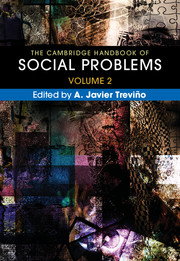Book contents
Part I - Problems Related to Health, Safety, and Security
Published online by Cambridge University Press: 16 March 2018
Summary
This chapter introduces several health-related social problems. The first is that there are health disparities by socioeconomic status and racial group. These disparities are long standing and persistent, despite overall improvements in health. Three models are used to explain health disparities: health behaviors, health care, and the physical and social environment. Next, we discuss the dauntingly complicated US health care system. We focus on two problematic aspects: the high costs of health care and lack of access to health care. We examine this both before and after the 2010 enactment of the Patient Protection and Affordable Care Act and find it will not significantly improve costs in the short run. It may not reduce health disparities given that the Medicaid expansion piece is voluntary. We conclude that there is much work to be done to create a fair and equitable health care system.
- Type
- Chapter
- Information
- The Cambridge Handbook of Social Problems , pp. 1 - 196Publisher: Cambridge University PressPrint publication year: 2018



